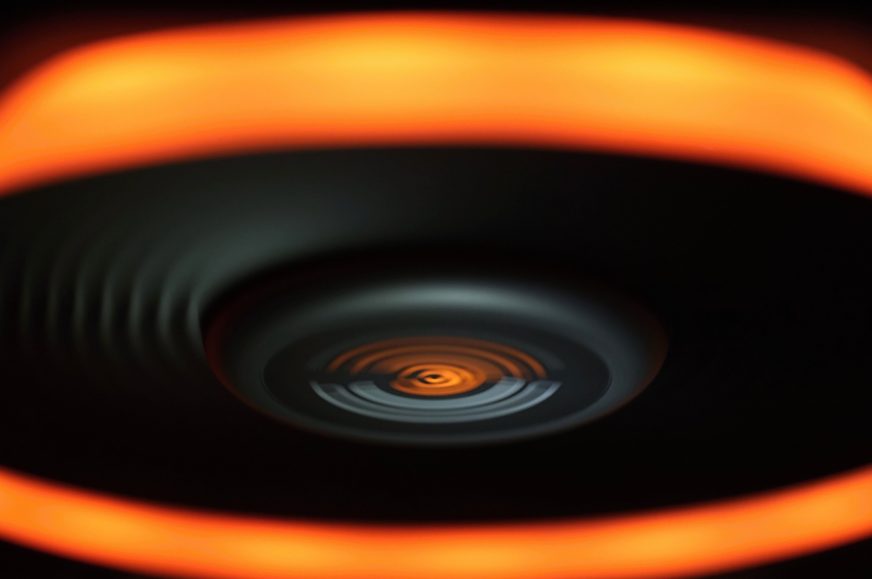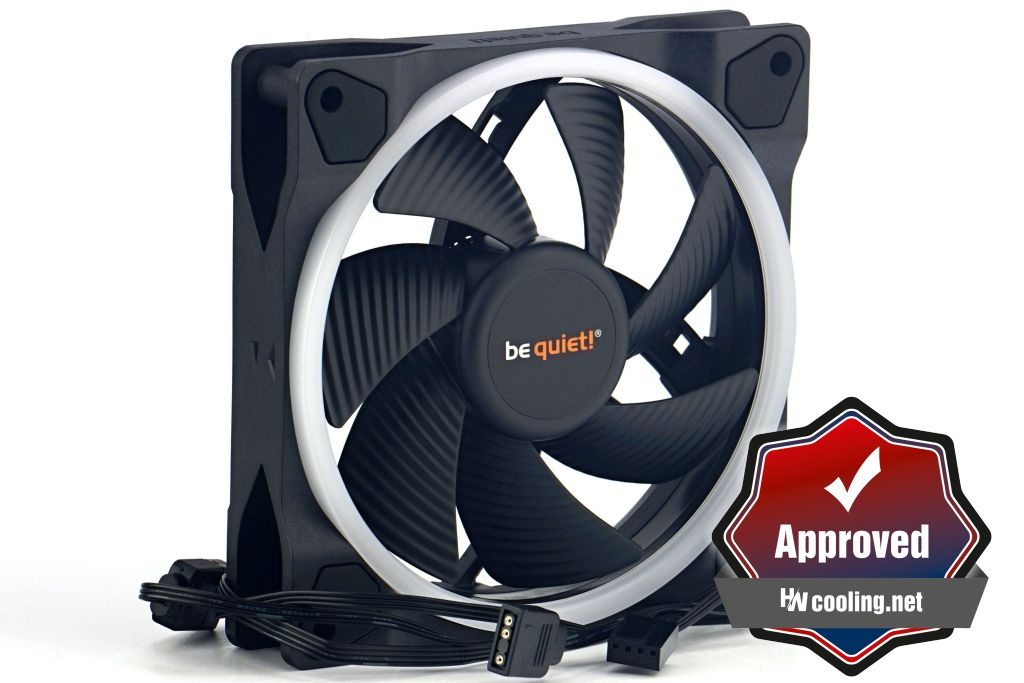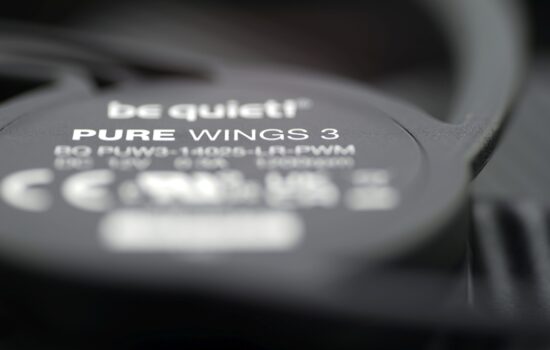Evaluation
Illuminated fans from BeQuiet! have the advantage over many competing models in a more robust rotor design. This is also due to the fact that it is not made of “light conductive” material and therefore some may not like the Light Wings fans, but aerodynamically they have the edge over other models. This is not only because of the choice of raw materials and their robustness, but also the overall shape of the blades.
Evaluation
The Light Wings fan in 120 mm format is one of the most efficient ARGB LED models in practice. Often it is also the most efficient, depending on the specific application. In ideal, unobstructed conditions (i.e. with almost no environmental resistance) some other illuminated fan always beats it, often the DeepCool FC120 with a larger active cross-section. But that’s because, in these conditions, the Light Wings doesn’t extract from high static pressure, which is top-notch from 1200 rpm upwards across normalized modes according to fixed noise levels. Not only compared to ARGB LED fans, but overall.
The more resistance the fan has to overcome (which in current cases is typically increased by the system cooling with negative pressure), the more it pulls ahead from competing models in terms of efficiency. At higher and high backpressure, across modes, the Light Wings is on average the most efficient 120mm fan with ARGB we’ve tested so far. However, due to the relatively lower RPM, the tested Light Wing variant BL072 cannot be considered a suitable choice if you require high performance. For such needs, the about 800rpm faster Light Wings BL073 is more suitable.
The BL072 is targeted for quiet running, even when installed on a grille, where microturbulence at lower speeds significantly increases the “hum” component of the sound at around 340 Hz relative to other frequencies. With Light Wings, this happens to a much lesser extent because the surface grooves make the airflow less turbulent at critical points, which is a good thing in this case. Ironically, it is rumblier, not only on the hexagonal grille, but also on the plastic filter at higher speeds. But those speeds are already disproportionately high in this environment, so it doesn’t really matter that much.
Unusually high frequencies around 700 Hz also “buzz” on the grille from about 1350 rpm. But again, these acoustic deficiencies appear already in the band to which few people will push the fan on a grille. Such high rpm don’t make much sense in the context of system cooling, and at lower rpm the sound is fine, non-intrusive to an above-standard degree.
We didn’t detect any vibrations, even at max speed. This also testifies to the high rigidity of the blades and also to the precision of the manufacturing, be it the rotor balance or the centering of the blades and similar mechanical details.
The power draw of the motor part is exceptionally low. Based on the very low starting speeds (~141 rpm), we can infer that internal friction will also be very low, even though “only” a 4-pole motor is used. It is, by the way, quite weak (with power only up to 2 W), but for the needs of this fan is still enough even with headroom, which will be “filled” over time, with use. But the service life will be shorter, even compared to Pure Wings 2 fans with the same type of bearings (rifle), where BeQuiet! reports a 33 % longer mean time between failures than with Light Wings fans (60,000 hours).
ARGB LED lighting is relatively inefficient in terms of energy: Relatively low luminosity (naturally resulting also from the smaller surface area of the light guide than in fans with light-conducting rotors) at above-standard high power draw. The good news is that the adjustability range is wide and the lighting can be dimmed very significantly, which can also be a plus in the dark of the night compared to other fans.
All in all, we can conclude that Light Wings (BL072), in a sea of illuminated fans, can represent one of the most sensible options when combined with the right application with the right settings.
English translation and edit by Jozef Dudáš
| BeQuiet! Light Wings (BL072) |
| + Suitable for every use |
| + Cooling efficiency (airflow/pressure per unit of noise) at a very high level |
| + High airflow even through the most restrictive obstacle... |
| + ... such as a grille on which this fan stands out among other illuminated ones |
| + Quiet motor and bearing operation |
| + Very low power draw (under 760 mW) |
| + Very low speeds possible (stable from approx. 141 rpm) |
| + Low operating power draw considering the airflow intensity |
| + Zero vibration across the entire speed spectrum |
| + Decent build quality |
| + ARGB LED illumination |
| - In some situations more pronounced frequency peaks in the sound |
| - Inefficient ARGB LED illumination (above-average power draw, below-average luminosity) |
| - Collides with nylon dust filter |
| Approximate retail price: 26 EUR |
- Contents
- Detaily BeQuiet! Light Wings (BL072)
- The basis of the methodology, the wind tunnel
- Mounting and vibration measurement
- Initial warm-up and speed recording
- Base 6 equal noise levels…
- ... and sound color (frequency characteristic)
- Static pressure measurement…
- … and airflow
- Everything changes with obstacles
- How we measure power draw and motor power
- Measuring the intensity (and power draw) of lighting
- Results: Speed
- Results: Airlow w/o obstacles
- Results: Airflow through a nylon filter
- Results: Airflow through a plastic filter
- Results: Airflow through a hexagonal grille
- Results: Airflow through a thinner radiator
- Results: Airflow through a thicker radiator
- Results: Static pressure w/o obstacles
- Results: Static pressure through a nylon filter
- Results: Static pressure through a plastic filter
- Results: Static pressure through a hexagonal grille
- Results: Static pressure through a thinner radiator
- Results: Static pressure through a thicker radiator
- Results: Static pressure, efficiency by orientation
- Reality vs. specifications
- Results: Frequency response of sound w/o obstacles
- Results: Frequency response of sound with a dust filter
- Results: Frequency response of sound with a hexagonal grille
- Results: Frequency response of sound with a radiator
- Results: Vibration, in total (3D vector length)
- Results: Vibration, X-axis
- Results: Vibration, Y-axis
- Results: Vibration, Z-axis
- Results: Power draw (and motor power)
- Results: Cooling performance per watt, airflow
- Results: Cooling performance per watt, static pressure
- Airflow per euro
- Static pressure per euro
- Results: Lighting – LED luminance and power draw
- Results: LED to motor power draw ratio
- Evaluation












